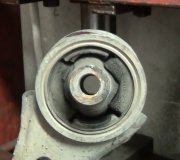What you are describing is a real common problem on GM front-wheel-drive cars after the engine or transmission were removed. It has to do with reinstalling the frame cross member. There is nothing, other than the mechanic's awareness of the potential problem, that insures that cross member will be properly centered. When it is not, it will change "camber" on the two front wheels by moving their bottoms to the left or to the right. While camber can be adjusted and made to look perfect, the underlying cause hasn't been addressed. That will cause the car to dart in various directions when hitting small bumps in the road. It will have no "predictability", meaning you have no idea which way it's going to go. This can't happen on Chrysler products because they have special bolts to force things to line up when put back together. On most Ford products the cross member is welded on and can't be removed or misadjusted, however, we still need to look for signs of something that is not equal on both sides. That is "steering axis inclination", (SAI). There is no spec given for that. All that is critical is it is the same on both sides. A typical value might be, oh, 28 degrees. You want the two readings to be within 0.2 degrees of each other.
The next thing is camber is the wheel leaning in or out on top, as viewed from in front of the vehicle. Ford has used some settings on their cars that are extremely horrendous for tire wear, as in 15,000 miles max per set, but they ride real nice. You could easily see those tires leaning over. This is not as much of a problem on their bigger vehicles, but it is one of the tricks they pull to sell more vehicles. Besides affecting tire wear, camber has the biggest effect on pulling to one side when you let go of the steering wheel. The two settings need to be the same to offset each other, then we make the left wheel just a little higher to create a slight pull to the left to offset "road crown". That is the roads slanting to the right so rain runs off.
"Caster" is a lot harder to explain, and you cannot see it, but it has about half the affect on pulling as does camber. Caster is what makes the steering wheel return to center on ts own after you make a turn. It also creates stability, or the tendency for the vehicle to not wander back and forth across the road. Instead of making camber slightly higher on the left to offset road crown, we can make caster slightly higher on the right wheel to do the same thing. Either one is perfectly acceptable. Where the problem comes in is you could have a 0.5 degree camber pull to the left, and if it is not possible to correct hat, you can adjust in 1.0 degrees pull to the right with caster to offset it. In theory the vehicle would go straight, but only when road forces are equal on both tires. That rarely happens in actual driving. In fact, the numbers on the alignment computer are only accurate for a vehicle that is standing still, not one in motion when the geometry of the suspension parts are going through their range of motions.
Camber affects how the tires tug on the road, and that changes as the road surfaces lean more or less. That is always changing as you drive. Caster makes a wheel want to flop in toward the center of the vehicle. With the steering linkage connecting the two sides, if both caster settings are equal, they'll offset each other and the car will go straight. The vehicle will dart to one side to follow the front tire with the least weight on it, and that too is constantly changing as you drive over even tiny bumps and ripples on the road surface. Also, too much caster can lead to what we call the "death wobble". The steering system wants to come back to centered, and comes back so fast, it overshoots and goes the other way. Road forces keep that going, like a grandfather clock pendulum, until you slow down. You'll never want to go through that again!
The point of all this is going back to my comment about unequal camber being offset with unequal caster, if those differences are bad enough, it can lead to any combination of the symptoms I described. This is the short version of what it took me eight weeks to teach.
One more thing you might consider is most trucks use a steering stabilizer, which is essentially, just a special shock absorber, connected to the steering linkage. When adjusting the alignment, or when replacing certain other parts, that stabilizer can end up slightly extended or retracted relative to where it was before. That is perfectly acceptable and normal, and has no effect on its operation, until it develops an internal worn spot. That can reduce its effectiveness when it's in that one orientation, and now that might be when the steering wheel is perfectly straight. It could fail to do its job when you are driving straight ahead. On many trucks that stabilizer ends up being bolted back on in a different orientation if we have to remove it for other services, and that rarely causes a problem. This is one of those things we have to think about when looking for the elusive cause of a problem.
Thursday, October 12th, 2017 AT 9:02 PM




